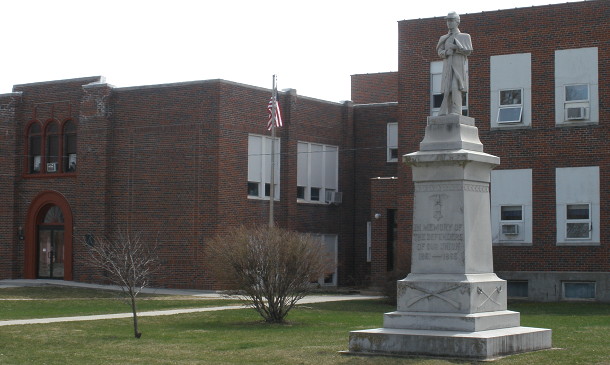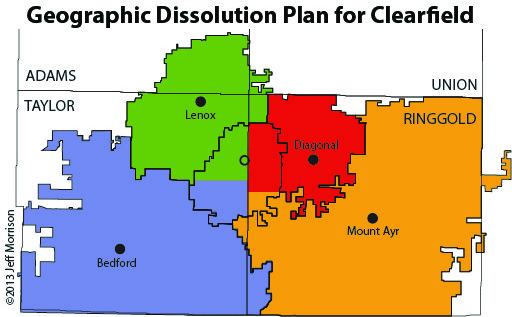
April 1, 2010: The stone soldier out front couldn’t guard against a century and a half of demographics. (Note: He faces north.)
Clearfield is the only school in Iowa I know of that has a Civil War monument on its grounds. Despite not even being incorporated until the 1880s, this town 16 miles from the Missouri border managed to get its own.
But the town’s population peaked in 1900 — a statistic that is not uncommon in Iowa. Today, it has a population of only 363, down from 698 at the turn of the previous century.
For years after losing the high school, Clearfield soldiered on. Likely because of its location, both centralized and isolated among four other districts, it let students in seventh grade and up enroll into their school of choice. But now, like districts on the opposite side of the state, holding on for dear life is no longer an option.
None of the four districts surrounding Clearfield — Bedford, Diagonal, Lenox, and Mount Ayr — were interested in a full merger. For Diagonal it wasn’t even an option; combining the second-smallest and fourth-smallest school districts in the entire state wouldn’t come close to a 300-student threshold.
Dissolution of a school district is rare in Iowa, but in this corner of the state it’s happened twice. Grand Valley, which straddled the Ringgold-Decatur county line, dissolved in 1998, divided up between Central Decatur and Mount Ayr. New Market, which straddled the Taylor-Page county line, dissolved in 2008, divided up between Clarinda and Bedford. Clearfield, right in the middle, will follow in 13 months.
Iowa gives a district great latitude in deciding the manner of its demise unless it repeatedly falls short on finances, including deciding where students will go. That, in turn, means already jagged school boundaries largely determined in the 1950s don’t get smoothed out when the opportunity comes.

This map is what I would propose as a way to divide Clearfield’s students. The county line runs north-south. To the west, the border is on 190th Street, and to the east, it is on the half-mile between 210 and 220th streets. This gives Diagonal and especially Lenox a greater number of students because small schools can use all the help they can get. It’s clean, simple, and totally not going to happen.
See that squiggle to the far east? That’s Mount Ayr snaking into the town of Grand River after Grand Valley went kaput. See the dents in Bedford’s west? That’s Clarinda poking into the remains of New Market. Even when given a golden opportunity, not only did borders wind up as skewed as ever, the towns themselves got carved up.
This article in the Mount Ayr Record-News gives the impression that the same thing is going to happen again. By certified enrollment, the district has 69 students on the Taylor County side and 13 on the Ringgold County side. The Record-News says Mount Ayr is a front-runner in preference for the east side of the district and the town kids are split between it and Lenox.
Although we’re only talking about 13 students here, extending Mount Ayr’s boundaries up the west side of Ringgold County could put some psychological pressure on tiny Diagonal. I say could, because Diagonal has been pretty darn tenacious and being surrounded on three 2½ sides by Decorah hasn’t made North Winneshiek buckle yet. (I still say that if doomsday does happen there should be a name change wrangled out of it.)
The other big question is what happens to the Clearfield building itself. If it’s not sold, whichever district gets that land will own it and want to unload it as soon as possible. The Record-News says the dissolution plan includes money for demolition — in effect, putting aside money for its own funeral.
How would Clearfield students in town react to going to districts far apart from each other? Could the Clearfield school building become the new headquarters of the Lions Club there? The Lions Club is the town’s most-known feature, running the shuttles at the Iowa State Fair. What will happen to the statue? In the next 13 months, a 132-year-old school district must find the answers to these questions as it prepares to fade into history.
